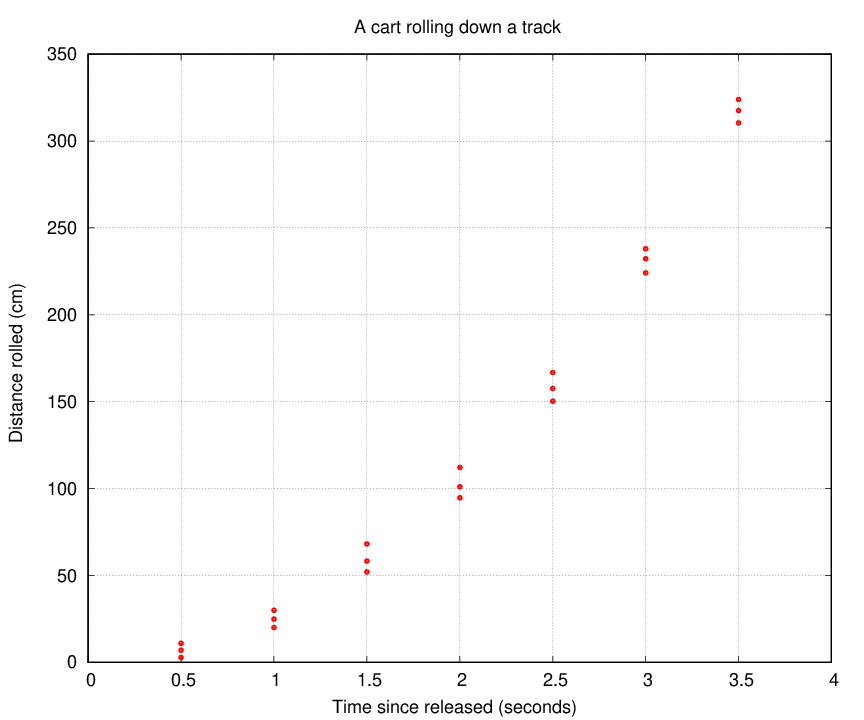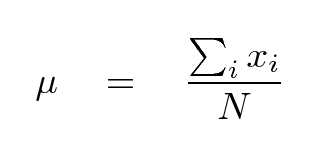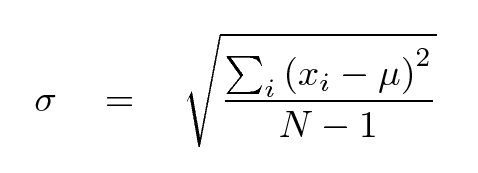
 Copyright © Michael Richmond.
This work is licensed under a Creative Commons License.
Copyright © Michael Richmond.
This work is licensed under a Creative Commons License.
I raised one end of a long track slightly, so that it was tilted from left to right. Then I placed a small cart on the track near the top, released it, and measured how far it rolled during several intervals. Here is a table of my measurements.
# Time Trial_1 Trial_2 Trial_3 Mean_pos Stdev_pos # (s) (cm) (cm) (cm) (cm) (cm) #------------------------------------------------------------------ 0.5 7.0 2.8 11.0 1.0 20.1 30.0 24.9 1.5 68.2 52.1 58.3 2.0 112.2 101.1 94.7 2.5 150.3 166.8 157.6 3.0 232.2 224.1 238.0 3.5 323.9 317.5 310.4 #------------------------------------------------------------------
A graph showing position as a function of time has a curved shape:

# Time Trial_1 Trial_2 Trial_3 Mean_pos Stdev_pos # (s) (cm) (cm) (cm) (cm) (cm) #------------------------------------------------------------------ 0.5 7.0 2.8 11.0 1.0 20.1 30.0 24.9 1.5 68.2 52.1 58.3 2.0 112.2 101.1 94.7 2.5 150.3 166.8 157.6 3.0 232.2 224.1 238.0 3.5 323.9 317.5 310.4 #------------------------------------------------------------------
Your first job is to turn the 3 measurements for each time value into a single value with an uncertainty. Therefore, your team should compute the MEAN and STANDARD DEVIATION of each set of positions.
What are they? Well, the mean is the same as the average.

For example, the mean position after t = 0.5 seconds is
7.0 + 2.8 + 11.0
mean = ------------------------- = 6.93 cm
3
The standard deviation is one way (not the only way) to represent the scatter of a bunch of numbers around their average value. Mathematically, one can compute it as follows:

The standard deviation of the position after t = 0.5 seconds is
0.5
[ (7.0 - 6.93)^2 + (2.8 - 6.93)^2 + (11.0 - 6.93)^2 ]
stdev = [ ------------------------------------------------------ ]
[ 2 ]
= 4.10 cm
You can find more examples for these calculations in my guide to uncertainties; scroll down near the end.
Each group must complete the following calculations. I recommend splitting the work up, and (if you have enough people) assigning two people to each calculation, so they can check each other.
t1 = 1.5 s x1 = 32.0 +/- 3.0 cm
t2 = 2.0 s x2 = 63.0 +/- 4.0 cm
(63.0 - 32.0) cm
avg velocity = --------------------- = 62.0 cm/s
(2.0 - 1.5) s
(63.0 + 4.0) - (32.0 - 3.0) cm
max velocity = --------------------------------- = 76.0 cm/s
(2.0 - 1.5) s
(63.0 - 4.0) - (32.0 + 3.0) cm
min velocity = --------------------------------- = 48.0 cm/s
(2.0 - 1.5) s
uncert in avg velocity = one half of (max - min)
= 0.5 * (76.0 - 48.0) cm/s
= 14.0 cm/s
avg velocity = 62.0 +/- 14.0 cm/s
When you have finished, call one of the instructors over so we can check that everthing looks correct.
Q: How might you write the acceleration of the cart?
Great! We now have estimates for the average velocity of the cart at different times as it rolled down the track. You should see that the velocity increases with time. In other words, the cart was accelerating.
Let's try to compute the average acceleration of the cart during each time interval between the average velocities.
Q: How might you describe the acceleration of the cart,
based on this graph?
If you drop a cart, it falls through the air with an acceleration which is about g = 980 cm/s2. How does that compare to the acceleration of my cart as it rolled down a ramp? Be quantitative!
 Copyright © Michael Richmond.
This work is licensed under a Creative Commons License.
Copyright © Michael Richmond.
This work is licensed under a Creative Commons License.